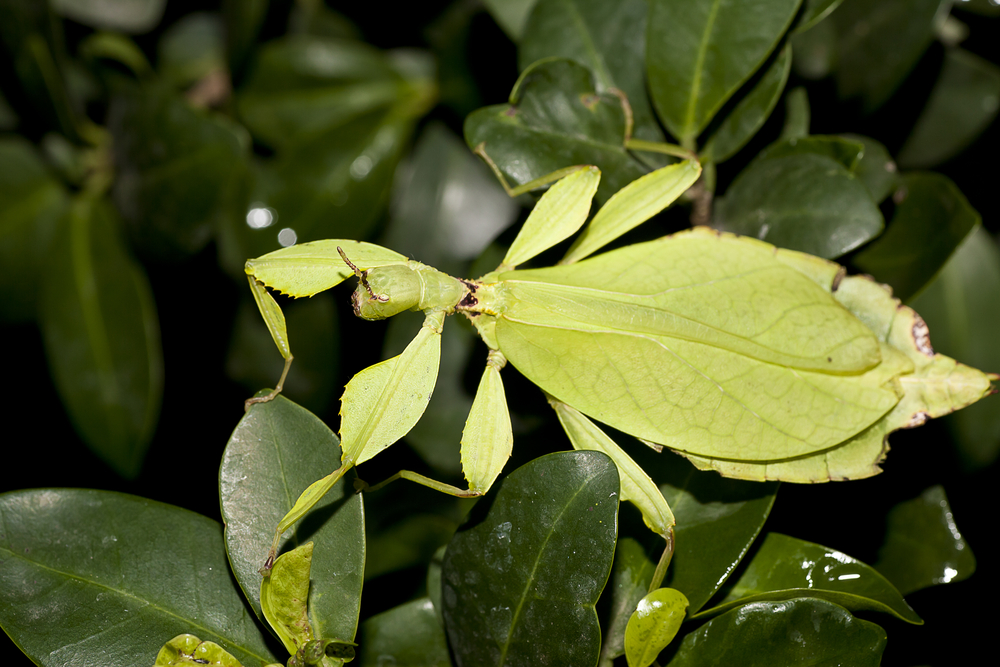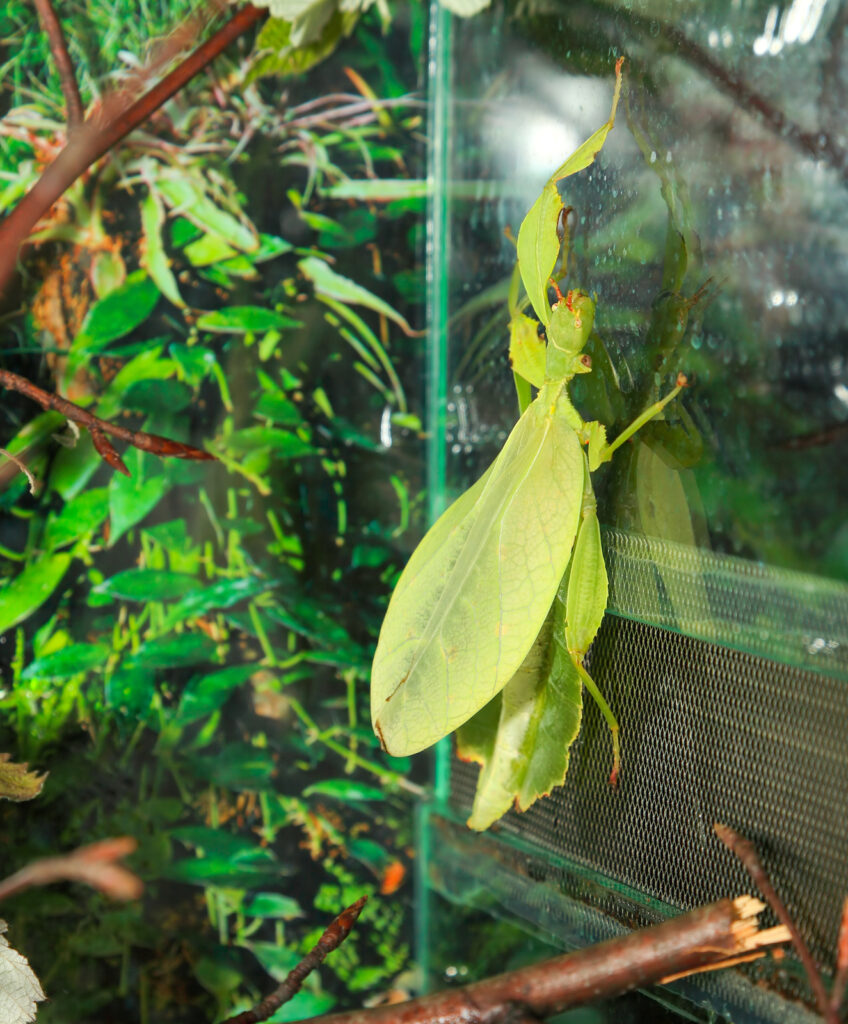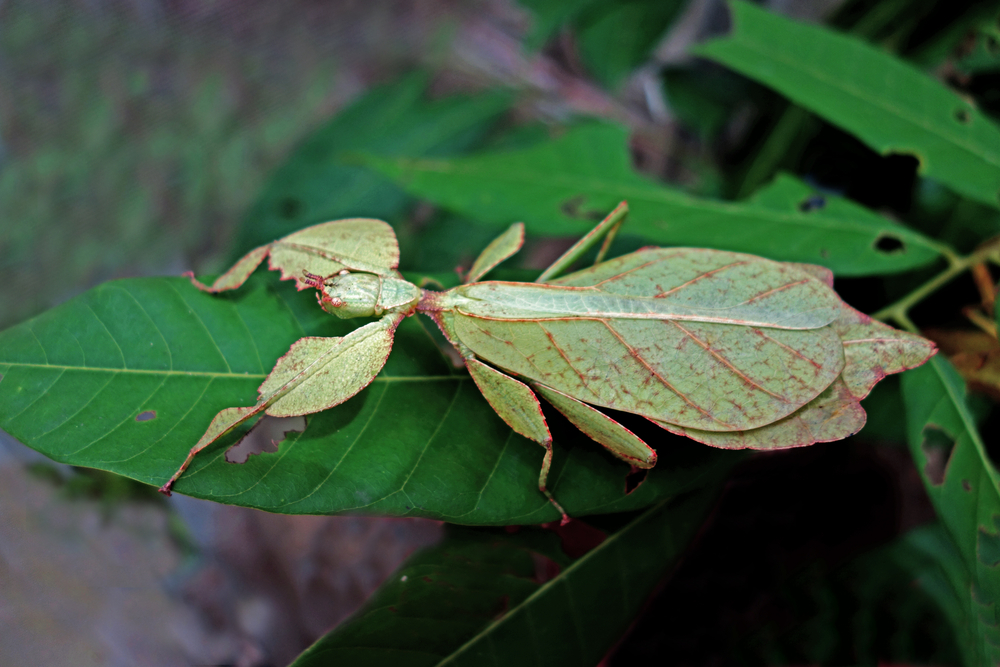The leaf bugs, family Phylliidae, is a fascinating member of the Phasmotodea, also known as the stick insects. They are found across Southeast Asia all the way to Australia but have become very popular in the pet trade due to their striking appearance, as the members of this family are perhaps the best leaf mimics in the entire animal kingdom. Despite their physical fragility and tropical homeland they are fairly undemanding in captivity, requiring only a steady food source, high humidity, and warmth to thrive.
Appearance
Leaf bugs are extremely beautiful insects that are amazing mimics of leaves. Different varieties of the species can have a variety of colors, from vivid green to muted browns and greys. Bright green is perhaps the most common, however. Their body is wide, flattened, leaf shaped, and can grow up to 3 inches long as an adult. Males are usually smaller and less stout than the females and have long wings. The females do have wings but are unable to fly.

Behavior
Leaf bugs are most active at night, which is when they feed. They are dedicated to maintaining the façade of being a leaf, and as such they move with a jerky back and forth motion that is attempting to mimic a leaf in the wind. When startled, the males will often attempt to fly away from danger.
Enclosure
This section shows you how to set up a leaf bug enclosure the right way.
Location
The leaf bug is a quiet insects that is easily stressed. Keep the enclosure away from heavily trafficked areas, away from pets and children. The enclosure should be in bright indirect light, allowing the leaf bugs to experience normal day and night cycles, but not in direct sunlight and away from drafts.
Enclosure Type
Leaf bugs should be kept in a tall enclosure, with enough vertical space to provide them with room to molt and climb. Make sure that the enclosure is at least 3 times as tall as the length of an adult leaf bug and provide a vertical limb upon which they can hang. Leaf bugs can be kept in a variety of enclosure types, including glass, acrylic, and net. Netcages provide the best ventilation and the most opportunities for climbing, while glass and acrylic enclosures maintain humidity but can become stuffy and limit air flow.
Decorations
Leaf bugs need to live in an enclosure with large amounts of vegetation. The easiest way to do this is keep colonies of leaf bugs on their host plant, which will also serve as their food source. You can provide branches of the host plant placed in water, or pots of the host plant growing in soil. You can provide supplemental climbing branches and sticks, but it is not a good idea to use artificial plants in leaf bug enclosures. Make sure there are a few areas where the leaf bugs can hang vertically and molt. This vertical space should be at least 3 times the length of the insect to facilitate molting.
Substrate
You should cover the bottom of your leaf bug enclosure with a kind of substrate. The best substrate to use depends on the location, temperature and kind of enclosure used. It should be absorbent, stabilize the humidity, and not mold easily.
- Paper towels: paper towels are a good emergency substrate but are not suitable for day-to-day use without changes once every couple days. Paper towels are very absorbent but soil very easily and can mold quite quickly. It is labor intensive to replace them and not the most affordable option, though most homes will have paper towels on hand.
- Coconut coir: coconut coir is an excellent substrate to use. It is widely available, sterile, and fairly cheap. It absorbs water and maintains humidity quite well.
- Soil: soil is a cheap, possibly free, option. It is variable in quality, but generally maintains humidity quite well. Because most soil is not sterile it is a good idea to sterilize it in an oven or microwave before use. Make sure that any soil you use as a leaf bug substrate is free of any fertilizers or pesticides.
- Bark: bark can work well as a leaf bug substrate as long as proper humidity is maintained. Barks dries quite quickly, so it is a better substrate when using glass or acrylic enclosures.
Temperature
Leaf insects come from the tropics and as such should be kept in tropical temperatures. You should keep the leaf bug at a temperature between 70 and 80 degrees Fahrenheit to ensure proper development. Keep a thermometer in the enclosure so that you can monitor the temperature and prevent excessive heat or cold. You can keep the enclosure warm with a heat mat, lamp, or ceramic emitter. Leaf bugs are delicate insects, so make sure the insects do not have direct access to heating lamps to prevent burns. You should place the heating element on one side of the cage to create a heat gradient, which will allow the insects to move between different parts of the enclosure according to their needs.
Humidity & Ventilation
Leaf bugs are tropical insects that require a fairly high level of humidity and excellent ventilation. Keep the humidity above 40%, preferably around 50%. Make sure you have excellent ventilation, however, which will prevent molding. Measure humidity with a hygrometer. You can keep the humidity high by misting the enclosure regularly.

Leaf Bug Diet
The leaf bug is fairly undemanding in their food requirements. They will feed on rose, bramble, or oak leaves. These leaves are fairly easy to find in most places. Harvest branches of these plants, or grow them in pots, and place them in the leaf bug enclosure. The leaf bugs will naturally find their food sources and need no prompting to begin feeding. Make sure you choose branches and leaves that have not been sprayed with pesticides, which can kill your leaf bugs.
Feeding Frequency
Leaf bugs need constant access to food, which in most cases serves as the decoration of the enclosure. It is best to keep leaf bugs on branches of their host plant placed in jars of water, to keep the leaves fresh. As the host plant either wilts or is eaten it should be replaced with new branches to prevent molding and spoilage. Many leaf bug keepers keep two vases of plant material in the enclosure at a time so they can switch out one vase while allowing the insects to continue feeding with minimal stress.
Tank Mates for Leaf Bugs
Looking to keep other inhabitants with you leaf bud? This section teaches you what you should and shouldn’t do.
Other Leaf Bugs
Leaf bugs are usually kept in breeding groups. They are peaceful creatures and are very easily kept in colonies. They breed very easily, are not cannibalistic, and do not fight amongst themselves.
Janitors
You can keep your leaf bugs with colonies of organisms that feed on waste and mold. These creatures will keep the enclosure clean and prevent molding, which can damage the health of your leaf bugs. Common cleaner organisms include some small tropical cockroach species, isopods, millipedes, beetles, and worms. These organisms will not bother your leaf bugs.
Other Organisms
Leaf bugs are delicate organisms that should not be kept most other organisms aside from colonies of small janitor species. They can in theory be kept with small stick insects that eat similar host plants and require similar living conditions, but due to the possibility of disease transfer and cannibalism this can be a difficult endeavor and it is best to keep them separately.
Handling Leaf Bugs
Though leaf bugs are quite docile in nature they are not well-suited for handling. They are very fragile insects that are very easily injured and can lose limbs extremely easily. You should avoid handling your leaf bugs whenever possible. If you must move them to different enclosures move slowly and allow the leaf bug to move itself onto your hand. Never grab your leaf bug and always keep a hand underneath them to prevent falls, which are often fatal.
Common Issues with Leaf Bugs
Here are some common issue associated with leaf bugs that you should look out for:
Molting
Leaf bugs can sometimes suffer from molting issues. Molting issues tend to happen when the humidity is too low, since the tropical leaf bug needs to be kept in hot, humid, tropical conditions. A leaf bug that is having trouble molting may simply have small pieces of old exoskeleton stuck to it or it may be unable to shed out of its own exoskeleton. Small pieces of exoskeleton can be removed with tweezers or left for the next molt, which should resolve the issue provided the humidity has been increased. More serious molting issues, however, can result in serious injury or the death of the insect. Prevent molting problems by providing sufficient heat and humidity.
Bacterial & Viral Disease
Leaf bugs can pick up viral and bacterial infections from contaminated foodstuffs or contact with other insects. These infections are often serious and usually fatal, which is why it is so important to keep your leaf bugs away from other insects. Make sure the food you give your leaf bugs is clean and free of insect frass. If you notice a leaf bug that is discolored, lethargic, or leaking fluid from the mouth and anus it is best to isolate it to prevent infecting the rest of the colony.
Fungus & Mold
Leaf bugs can be sensitive to fungal pathogens. Fungal pathogens rapidly cause death of captive insects and as such it is important to watch for symptoms of fungal disease, like blackening body segments, lethargy, mottled color, and confusion. Remove these insects from the enclosure to a different one, as fungal pathogens can rapidly spready through a colony. Fungal infections are usually caused by excessive humidity combined with poor ventilation, often exacerbated by low temperatures. Leaf bugs should be kept in well-ventilated enclosures and kept well-heated.
Injury
Leaf bugs are slow and deliberate climbers, not prone to falls. They are not a good insect for regular handling, however, as they very easily lose their limbs. Losing a limb or two is not terribly serious for leaf bugs, as they will still be able to climb and eat normally.
Immature leaf bugs are quite capable of regenerating limbs when they molt. It may take multiple molts until the limb appears normal, however. Adult leaf bugs, however, are finished molting and will not regenerate any limbs. A leaf bug that is missing more than two limbs or both front legs may have a hard time eating and climbing normally and likely will need to be euthanized.
Pesticides
Leaf bugs feed on plant material, often collected from outdoors. It is extremely important to collect pesticide-free plant material when looking for leaf bug food, with the safest option usually being to grow the plant yourself. Pesticide poisoning is irreversible and almost always fatal, so leaf bugs exposed to pesticides are best euthanized.
Leaf Bug Lifespan
Leaf bugs have a fairly long lifespan, often living more than a year from egg to adult. As these insects age they will often show some age-related deterioration, often becoming clumsier and poorer climbers. This can lead to accidents which can cause limb loss and bodily injury. If a leaf bug is no longer able to function properly (cannot climb, cannot eat, etc) it is probably most humane to euthanize it. The best way to euthanize most insects is either via placing them in pure CO2 or by placing them in the freezer.
Breeding
Because leaf bugs can be kept in groups they generally need no prompting to mate. They will begin mating once they reach maturity and within several weeks of their last molt they will begin to lay eggs. Females can lay more than 40 hours over the course of their lifespans, usually only laying one egg at a time.
- The adults will not cannibalize eggs but it is a good idea to remove them from the cage anyways and place them on moist sand.
- Keep this container warm, around 22 degrees Celsius, and wait for the eggs to hatch.
- When eggs hatch, place the nymphs onto a food plant. Cut or smash the leaves to stimulate feeding, as young leaf bugs may not be able to chew the leaves well.
